Abstract
In a study of retinopathy during one year of tight blood glucose control 45 type I (insulin dependent) diabetics without proliferative retinopathy were randomised to receive either continuous subcutaneous insulin infusion, multiple insulin injections, or conventional insulin treatment (controls). Near normoglycaemia was achieved with continuous infusion and multiple injections but not with conventional treatment. Blind evaluation of fluorescein angiograms performed three monthly showed progression of retinopathy in the control group, transient deterioration in the continuous infusion group, and no change in the multiple injection group. Half the patients receiving continuous infusion and multiple injections developed retinal cotton wool spots after three to six months. These changes regressed in all but four patients after 12 months. Control patients did not develop cotton wool spots. Patients who developed cotton wool spots are characterised by a larger decrement in glycosylated haemoglobin and blood glucose values, more frequent episodes of hypoglycaemia, a longer duration of diabetes, and more severe retinopathy at onset. A large and rapid fall in blood glucose concentration may promote transient deterioration of diabetic retinopathy.
Full text
PDF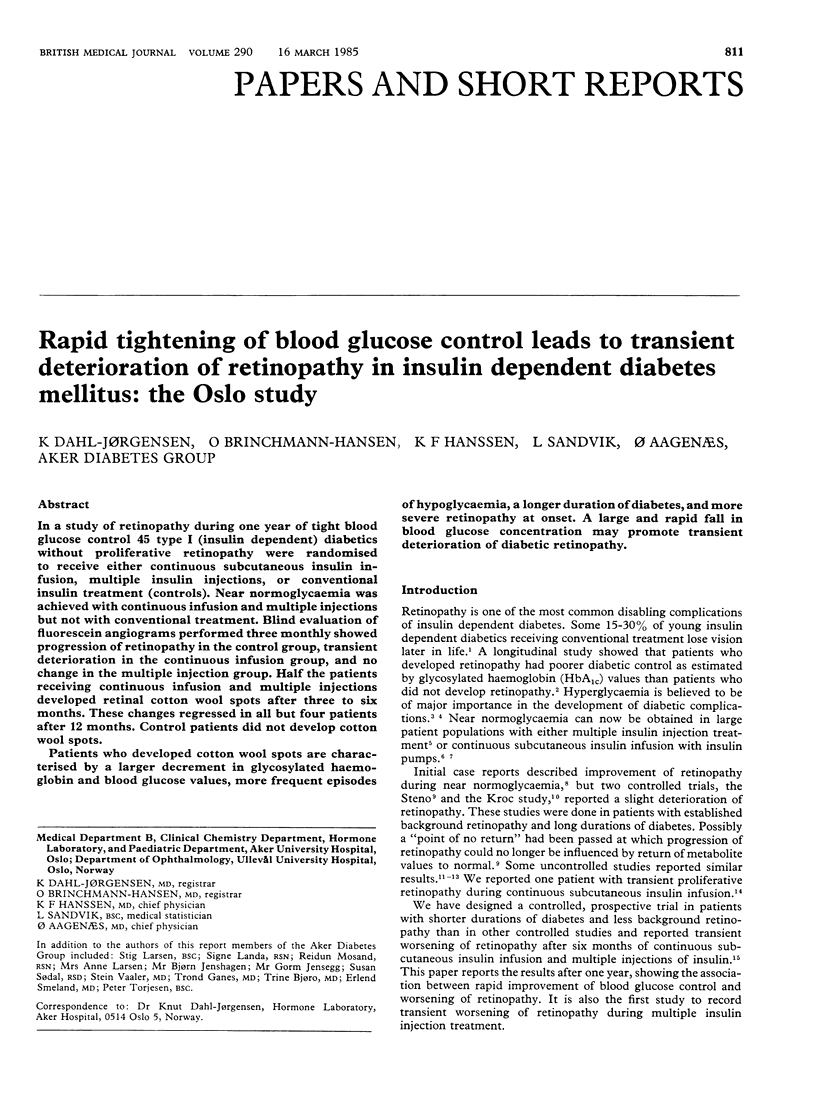
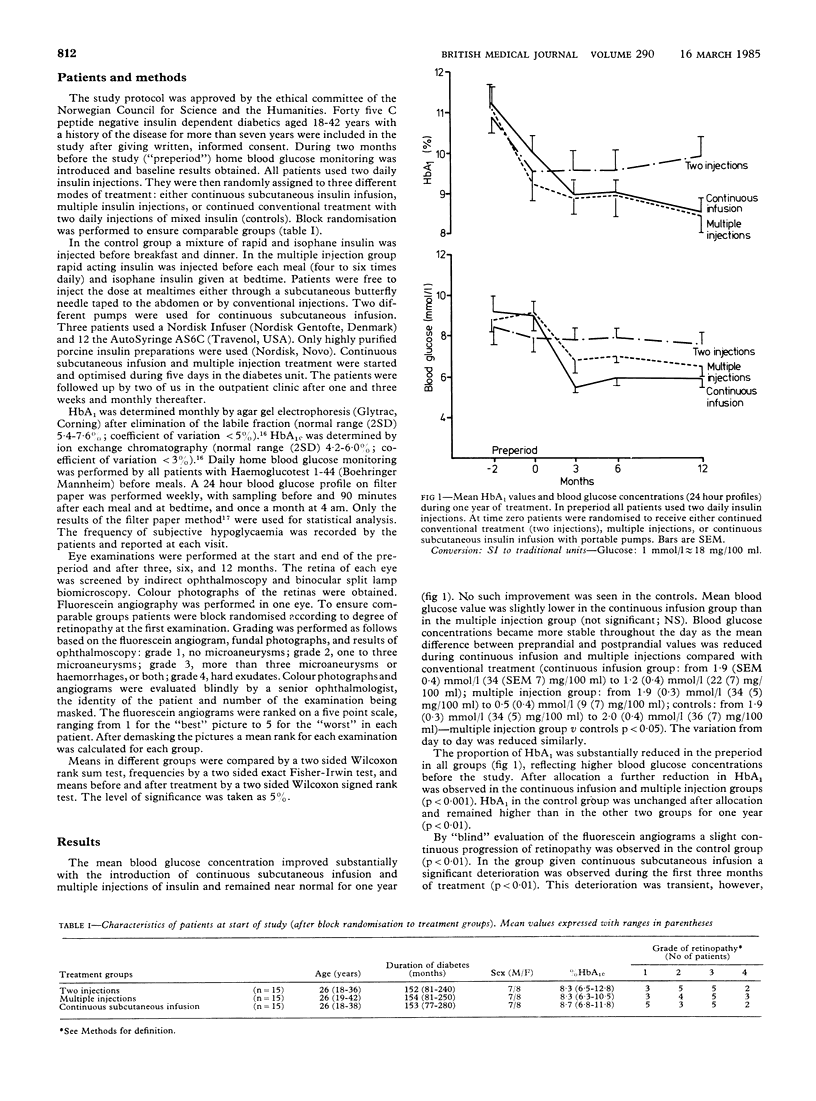
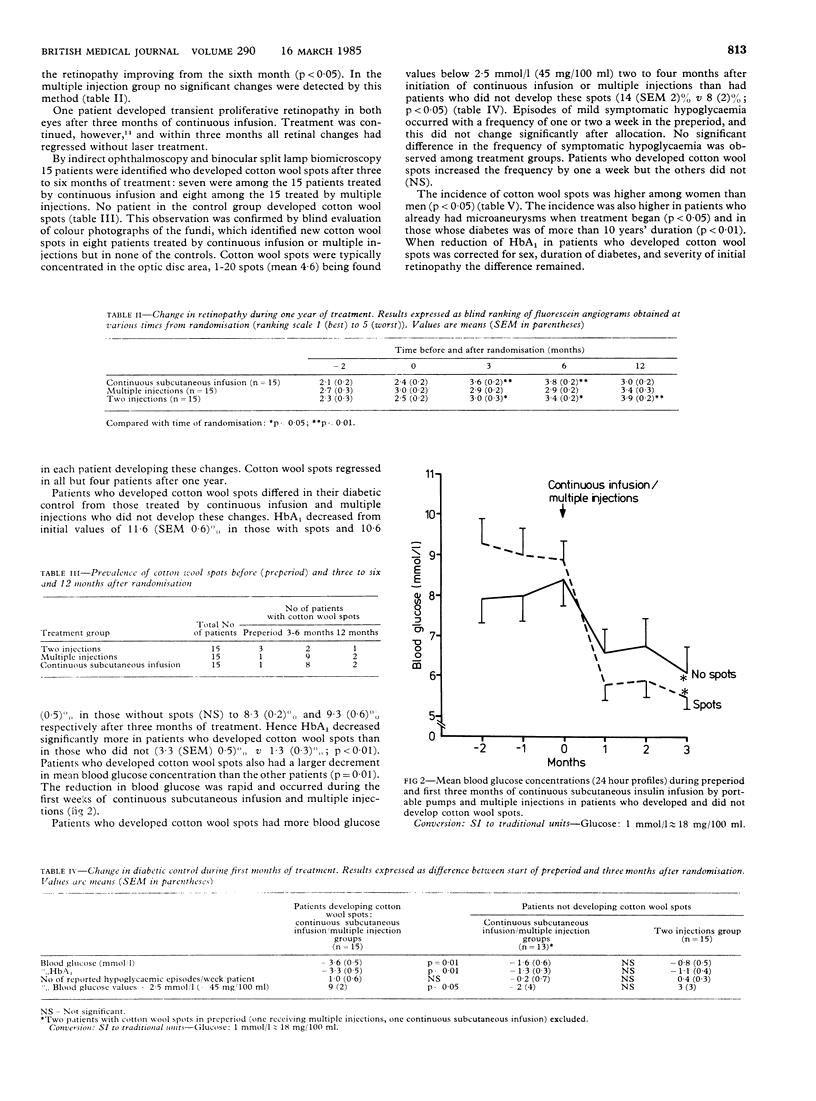
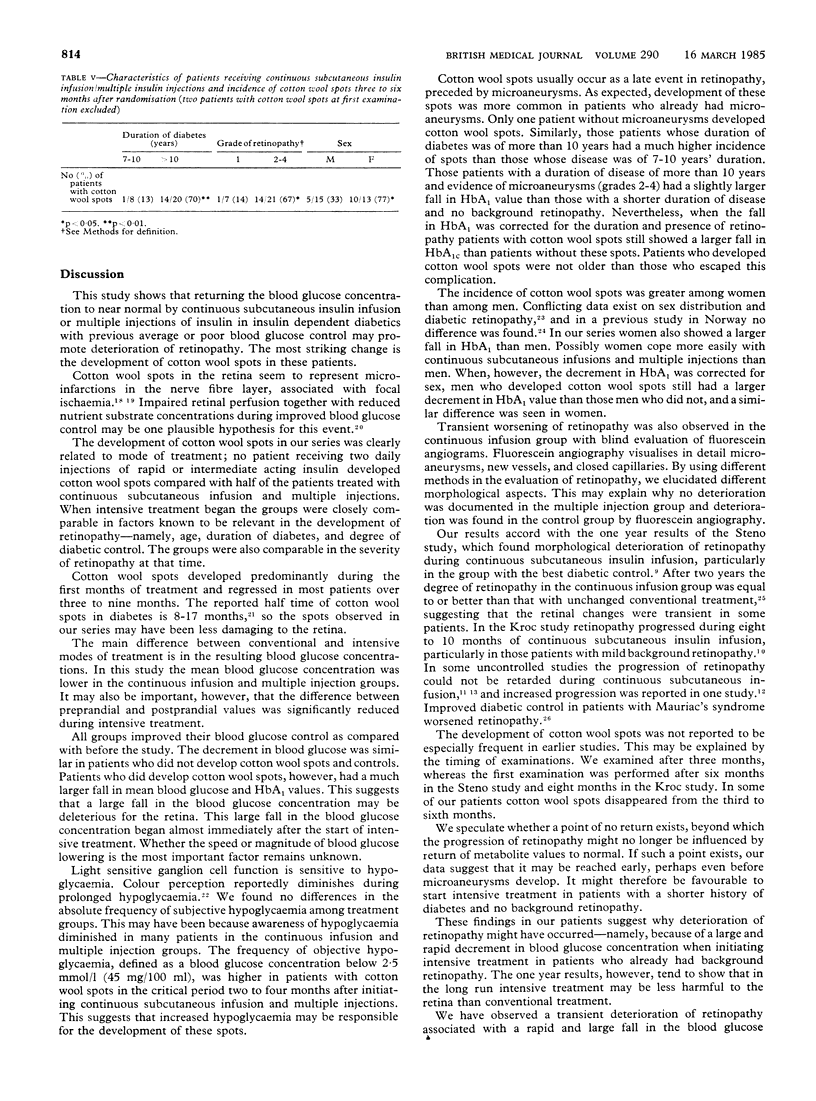
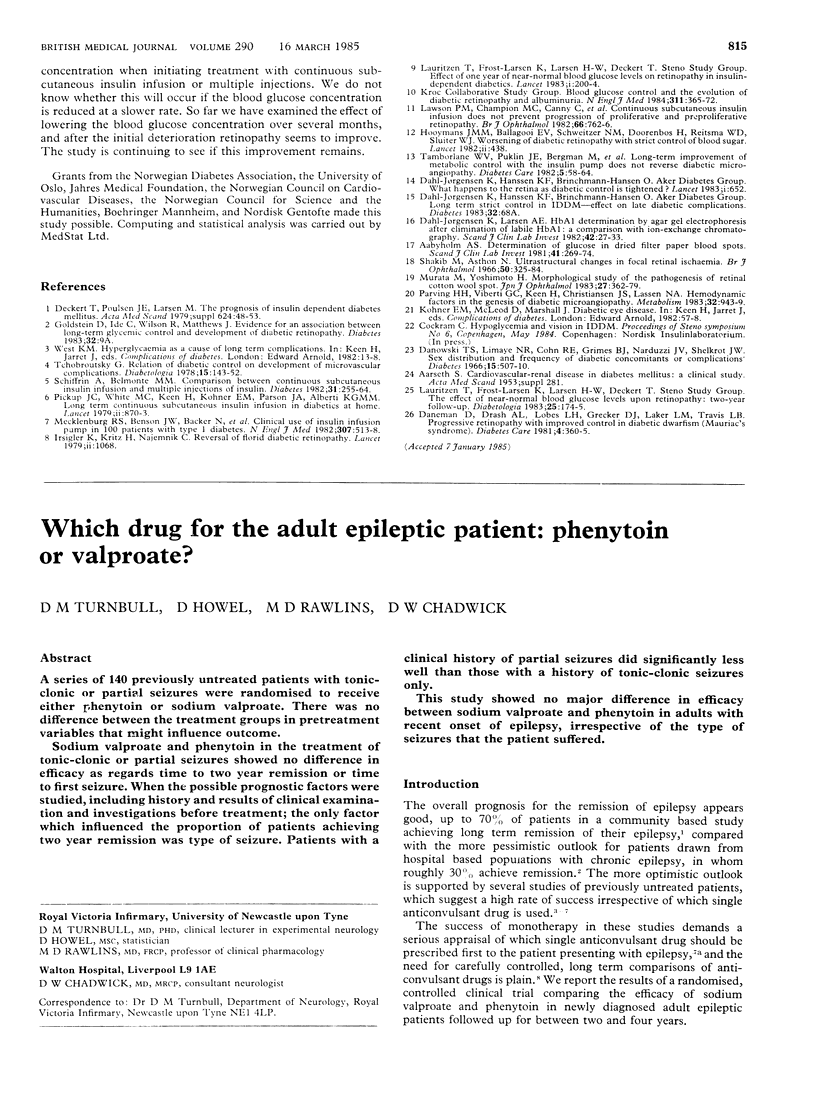
Selected References
These references are in PubMed. This may not be the complete list of references from this article.
- Dahl-Jørgensen K., Larsen A. E. HbA1 determination by agar gel electrophoresis after elimination of labile HbA1: a comparison with ion-exchange chromatography. Scand J Clin Lab Invest. 1982 Feb;42(1):27–33. doi: 10.1080/00365518209168046. [DOI] [PubMed] [Google Scholar]
- Daneman D., Drash A. L., Lobes L. A., Becker D. J., Baker L. M., Travis L. B. Progressive retinopathy with improved control in diabetic dwarfism (Mauriac's syndrome). Diabetes Care. 1981 May-Jun;4(3):360–365. doi: 10.2337/diacare.4.3.360. [DOI] [PubMed] [Google Scholar]
- Danowski T. S., Limaye N. R., Cohn R. E., Grimes B. J., Narduzzi J. V., Shelkrot J. W. Sex distribution and frequency of diabetic concomitants of complications. Diabetes. 1966 Jul;15(7):507–510. doi: 10.2337/diab.15.7.507. [DOI] [PubMed] [Google Scholar]
- Deckert T., Poulsen J. E., Larsen M. The prognosis of insulin dependent diabetes mellitus and the importance of supervision. Acta Med Scand Suppl. 1979;624:48–53. doi: 10.1111/j.0954-6820.1979.tb00718.x. [DOI] [PubMed] [Google Scholar]
- Hooymans J. M., Ballegooie E. V., Schweitzer N. M., Doorebos H., Reitsma W. D., Slutter W. J. Worsening of diabetic retinopathy with strict control of blood sugar. Lancet. 1982 Aug 21;2(8295):438–438. doi: 10.1016/s0140-6736(82)90464-0. [DOI] [PubMed] [Google Scholar]
- Irsigler K., Kritz H., Najemnik C., Freyler H. Reversal of florid diabetic retinopathy. Lancet. 1979 Nov 17;2(8151):1068–1068. doi: 10.1016/s0140-6736(79)92458-9. [DOI] [PubMed] [Google Scholar]
- Lauritzen T., Frost-Larsen K., Larsen H. W., Deckert T. Effect of 1 year of near-normal blood glucose levels on retinopathy in insulin-dependent diabetics. Lancet. 1983 Jan 29;1(8318):200–204. doi: 10.1016/s0140-6736(83)92585-0. [DOI] [PubMed] [Google Scholar]
- Lawson P. M., Champion M. C., Canny C., Kingsley R., White M. C., Dupré J., Kohner E. M. Continuous subcutaneous insulin infusion (CSII) does not prevent progression of proliferative and preproliferative retinopathy. Br J Ophthalmol. 1982 Dec;66(12):762–766. doi: 10.1136/bjo.66.12.762. [DOI] [PMC free article] [PubMed] [Google Scholar]
- Mecklenburg R. S., Benson J. W., Jr, Becker N. M., Brazel P. L., Fredlund P. N., Metz R. J., Nielsen R. L., Sannar C. A., Steenrod W. J., Jr Clinical use of the insulin infusion pump in 100 patients with type I diabetes. N Engl J Med. 1982 Aug 26;307(9):513–518. doi: 10.1056/NEJM198208263070901. [DOI] [PubMed] [Google Scholar]
- Murata M., Yoshimoto H. Morphological study of the pathogenesis of retinal cotton wool spot. Jpn J Ophthalmol. 1983;27(2):362–379. [PubMed] [Google Scholar]
- Parving H. H., Viberti G. C., Keen H., Christiansen J. S., Lassen N. A. Hemodynamic factors in the genesis of diabetic microangiopathy. Metabolism. 1983 Sep;32(9):943–949. doi: 10.1016/0026-0495(83)90210-x. [DOI] [PubMed] [Google Scholar]
- Pickup J. C., White M. C., Keen H., Parsons J. A., Alberti K. G. Long-term continuous subcutaneous insulin infusion in diabetics at home. Lancet. 1979 Oct 27;2(8148):870–873. doi: 10.1016/s0140-6736(79)92686-2. [DOI] [PubMed] [Google Scholar]
- Schiffrin A., Belmonte M. M. Comparison between continuous subcutaneous insulin infusion and multiple injections of insulin. A one-year prospective study. Diabetes. 1982 Mar;31(3):255–264. doi: 10.2337/diab.31.3.255. [DOI] [PubMed] [Google Scholar]
- Shakib M., Ashton N. II. Ultrastructural changes in focal retinal ischaemia. Br J Ophthalmol. 1966 Jun;50(6):325–384. doi: 10.1136/bjo.50.6.325. [DOI] [PMC free article] [PubMed] [Google Scholar]
- Tamborlane W. V., Puklin J. E., Bergman M., Verdonk C., Rudolf M. C., Felig P., Genel M., Sherwin R. Long-term improvement of metabolic control with the insulin pump does not reverse diabetic microangiopathy. Diabetes Care. 1982 May-Jun;5 (Suppl 1):58–64. [PubMed] [Google Scholar]
- Tchobroutsky G. Relation of diabetic control to development of microvascular complications. Diabetologia. 1978 Sep;15(3):143–152. doi: 10.1007/BF00421230. [DOI] [PubMed] [Google Scholar]
- What happens to the retina as diabetic control is tightened? Lancet. 1983 Mar 19;1(8325):652–653. doi: 10.1016/s0140-6736(83)91826-3. [DOI] [PubMed] [Google Scholar]


